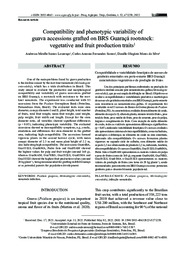Compatibility and phenotypic variability of guava accessions grafted on BRS Guaraçá rootstock: vegetative and fruit production traits.
Compatibility and phenotypic variability of guava accessions grafted on BRS Guaraçá rootstock: vegetative and fruit production traits.
Author(s): LOURENÇO, A. M. S.; SANTOS, C. A. F.; SILVA, D. O. M. da
Summary: One of the main problems faced by guava production is the decline caused by the root-knot nematode (Meloidogyne enterolobii), which has a wide distribution in Brazil. This study aimed to evaluate the productive and morphological compatibility and variability of guava accessions grafted on BRS Guaraçá, a rootstock with resistance to the root-knot nematode. The experiment was conducted with 83 accessions from the Psidium Germplasm Bank (Petrolina, Pernambuco State, Brazil). The evaluated traits were stem diameter, canopy diameter I and II, plant height, total number of fruits, total fruit weight, mean fruit weight, seed weight, pulp weight, fruit width and length. Except for the stem diameter ratio, all variables showed significant diferences (p < 0.05), indicating phenotypic variability. The evaluated accessions showed no incompatibility symptoms, e.g., cracks, exudations and diferences for stem diameter in the grafted area, indicating high compatibility. The accessions formed vigorous plants in the second harvest cycle, with mean canopy diameter of 2.3 m and mean plant height of 2.2 m, also indicating high compatibility. The accessions Gua64BA, Gua181ES, Gua06MA, Pedro Sato and Gua99AM showed the highest values for pulp and fruit weight (around 160 g), whereas Gua96AM, Gua70RO, Gua192ES, Gua01MA and Gua183ES showed the highest fruit production values (around 20 kg plant−1), being recommended for grafting in BRS Guaraçá or as potential parents for population development.
Publication year: 2022
Types of publication: Journal article
Unit: Embrapa Semi-arid Region
Observation
Some of Embrapa's publications are published as ePub files. To read them, use or download one of the following free software options to your computer or mobile device. Android: Google Play Books; IOS: iBooks; Windows and Linux: Calibre.
Access other publications
Access the Agricultural Research Database (BDPA) to consult Embrapa's full library collection and records.
Visit Embrapa Bookstore to purchase books and other publications sold by Embrapa.

